A few months ago, Overthinking It Benevolent Dictator For Life Matt Wrather and I got into a friendly argument about GIFs on the website’s back channel. I should preface this: here at OTI, like pretty much every hip distributed team these days, we use Slack to take care of scheduling, pitching article ideas, and so on.
If you’re unfamiliar: Slack basically works like a series of chatrooms — so of course we also (mainly) use it to chat. The Think Tank posts are usually transcribed directly from the conversations we have on Slack while we’re supposed to be writing something else. Now, if Slack were just a chat service, it’d be hard to justify using it. But it has a bunch of extra bells and whistles, many of which are incredibly useful. And probably the least useful of these — and the most used, at least by us — is the /giphy tag. The way this works is that you type /giphy hotdogs (or whatever), and then Slack searches the GIF aggregation service giphy.com for hotdogs, picks one of the results at random, and inserts this into the chat. The results are often hilariously irrelevant: for every GIF that’s totally on point, you’ll get two where you’re like “why did anyone tag this with hotdogs?” Or “why is this even on film?”
(Here are the first three /giphy results for “why is this even on film,” by the way.)


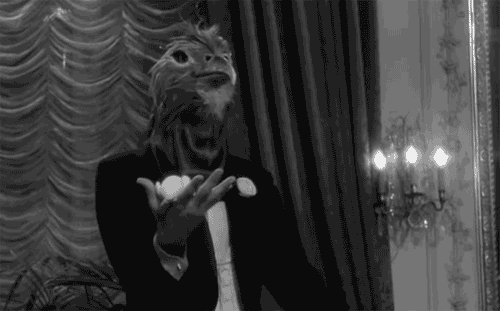
So anyway, we’ve all been abusing the /giphy tag heavily in the back channel, and this got Matt and me thinking about the broader nature of the GIF as a bearer of meaning. Matt was arguing that GIFs pick up where words leave off: sometimes what we feel is too profound for cloddish language to express, but in these circumstances we can fall back on GIFs, which are — both emotionally and visually — a lossless image format. Apparently, the thing that admits no impediment to the marriage of true minds turns out to be a GIF: kind of a shame that Shakespeare, and everyone else who lived before the Internet, never got to communicate authentically with anyone. (On the other hand, they didn’t have to put up with people misrepresenting their arguments in a blog post months after the fact, so I guess it’s kind of a wash.) For my part, I was arguing that GIFs are always kind of off: quite aside from the intentional randomness of the /giphy tag, even the most “perfect” GIF is going to be a near miss for the emotion that we’re trying to express through it.
I thought this was a really interesting conversation, and I think it’s worth reviving here on the website. (Plus it gives me a chance to make a post with dozens of GIFs in it, which is absolutely my idea of a good time.)
So how do GIFs mean? As I see it, there are basically three possibilities:
1) Matt’s view: The Perfect GIF Exists. A picture’s worth a thousand words (per frame).
Wrather’s argument, as far as I understand it, basically works like this:
First, I feel a certain way about a thing: there’s an emotion that I want to express. And words simply will not do. So I search around until I find The Perfect GIF that captures my emotion exactly.

“You know what this post needs?” “The Perfect GIF.”
And then I post that GIF on tumblr, baring the furthest reaches of my soul.
It’s not that people really go searching for The Perfect GIF, at least not most of the time… usually you do your searching in advance, just by being exposed to movies, TV, and GIFs that other people have posted. Later on, when you have that feeling that you want to express, you think back to a clip that you’ve already seen. “You know what would be perfect for this,” you think to yourself, “that one of the magician with a chicken head.”

Said no one, ever.
This isn’t such an extravagant claim. It’s not suggesting that there’s a GIF out there for EVERY emotion, just that in the course of human events we OCCASIONALLY feel something that is entirely expressed, in all its haecceity, by MichaelJacksonEatingPopcorn.gif. And this is why we have recourse to GIFs in the first place: mere words will never capture an emotion as perfectly as a GIF can. If you really DO want to expose your soul — and let’s face it, if you didn’t want to expose your soul, why even HAVE a tumblr — the GIF is the medium that’ll let you do it.

Me, looking at your soul.
Now, mind you: that GSAT word that I dropped on you in the last paragraph, “haecceity,” is the technical philosophical term for “a degree of specificity that cannot be captured by a five second looping clip.” This brings us to the second possibility:
2) My view: The Perfect GIF Does Not Exist. A picture’s worth a thousand rhetorical devices.
This is the full version of my own argument. (Assume that I’m probably being a little fairer to myself than I was to Wrather.) It starts pretty much the same way, with me feeling a certain way about a thing: again, there’s an emotion that I want to express, and again, words simply will not do. But even if I scan through every GIF on the internet (just shy of four million, according to a recent Google Labs study), I’m never going to find “The Perfect GIF.” Close enough is the best that I can hope for — and it genuinely is ALL that I hope for. I’m not even looking for the Perfect GIF, all I want is something that will point in the general direction of the way that I actually feel.
There are weaker and stronger versions of this claim. Maybe I’m just saying that the odds aren’t in my favor: that even four million GIFs is a drop in the bucket next to the forty billion distinct flavors of human emotion. On the other hand, maybe I’m saying that human emotions are, by their very nature, too complex (or maybe just too specific) to be perfectly expressed in GIF form. But there’s little practical difference. The vast majority of GIFs that we use, and the vast majority of GIFs that we encounter, are not perfect. Settling — accepting the particular GIF in front of you as sufficient for (though not equal to) your emotion — is such a normal part of the process that we don’t even think of it as settling. It doesn’t feel like giving up, it feels like achieving something. If you track back to the argument that originally inspired this post, I’m assuming that my friends who do believe in The Perfect GIF have been misled by this: that when Wrather uses a GIF, he THINKS that he’s thinking “this is perfect,” when in fact he is thinking “this will do.” (So yes, this argument requires me to be a SMUG ASSHOLE. I guess I just know Matt’s thought processes SO MUCH BETTER than he does himself, huh?)
(Here is the first /giphy result for “smug asshole,” by the way.)

But in my defense, I don’t see how it can work any other way. Let’s at least agree on this: it is at least possible to use a GIF that doesn’t capture your emotion completely. Like if I post this GIF with the caption “Tfw you eat the picante sauce at Taco Bell”
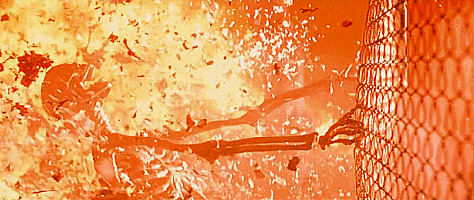
Live Más
…you, and I, and everybody reading, will recognize that, no, that feel was NOTHING like this image! Folks, their sauce is simply not that spicy. By posting this image, I am employing the rhetorical trope of hyperbole to indicate that the sauce was, at most, quite spicy. And at this point, the GIF enters into the realm of discourse.
The term discourse means lots of different things (even as used by the writers on this one website). Personally, when I describe something as discourse, I’m trying to highlight the fact that it’s a communication from someone to someone else: that there’s a sender, a message, and a receiver. (This is very far from being my own idea, of course.) If we consider the GIF as discourse, the relationship between the GIF and the sender’s emotion almost ceases to matter! Because what the sender cares about, primarily, is what effect the GIF will have on the receiver. Suppose that I have exactly one Tumblr follower, and he’s Drax the Destroyer (who as we all remember, doesn’t acknowledge the existence of figurative language). Would I under any circumstances send Drax that Terminator 2 GIF as my reaction to hot sauce? Think for a minute about how that would go down: “I am saddened to learn of your flesh’s incineration. Know that I, Drax, will avenge your tragic and flavorful death! This ‘Taco Bell’ of which you speak has made a powerful enemy.”

Finger across the throat means fourthmeal!
If we all read GIFs like Drax, then it would make sense to only send GIFs that capture our emotions perfectly. But that’s not an ordinary human response. The human response is to read the feeling that’s in the GIF (Emotion1), and then use this to try to reverse-engineer — based on contextual clues — the communicative intent that lies behind the GIF (Emotion2). The distance between Emotion1 and Emotion2 is itself expressive. Sticking with the hot sauce example, imagine that you’re doing consumer research for Taco Bell, and you get back two survey cards, one describing the sauce as “flesh obliterating,” and another describing it as “not too spicy.” Now you might think that the first person thought the sauce was spicier… but I honestly think that’s secondary. Because we all know how spicy that sauce isn’t! (That’s the contextual clue.) The first person probably thought it was a LITTLE spicier, but the main thing we’ve learned here is that this is the kind of chucklehead who puts ironic answers on consumer response surveys.
(Here is the first /giphy result for “not too spicy,” by the way.)
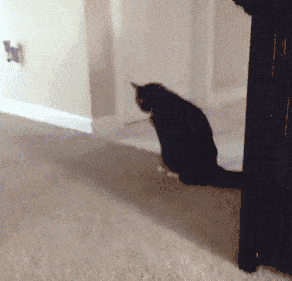
And once we’ve established that GIFs can work discursively, it seems inescapable to me that they must always work that way. When we first had this back-and-forth in the back channel, some of us were trying to argue that GIFs are inherently trivial, and Wrather pulled out this loop of David Tennant standing in the rain to prove that GIFs could express profound human emotions.
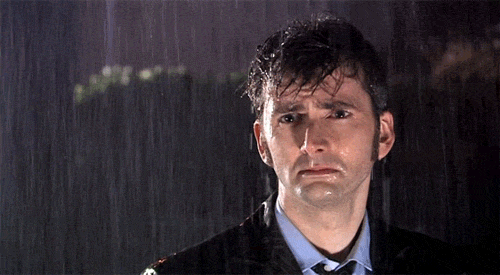
Okay, well and good. This does feel pretty profound. But which profound emotion is being expressed? This depends, to a certain extent, on how Wrather feels about rain. (Is it just an emotional amplifier, as in Nicholas Sparks? Or are we meant to feel the specific misery of a wet person who desperately wants to be dry?) How does Wrather feel about David Tennant — and how does he feel about Dr. Who? Which one of them are we supposed to be sympathizing with here? (Actually, are we supposed to be sympathizing at all? Or are we meant to be projecting ourselves into the character’s shoes, which is more of an empathetic kind of moment?) All of these questions are black-box aspects of Wrather’s own particular reaction to the GIF, knowable only to him. So if he’s trying to communicate at ALL — if he’s not just posting the GIF introspectively, as some kind of performative therapy — he’s not trying to communicate those particular aspects of his experience, but rather a generalized sense of grief. Or rather, of “GRIEF!” (Just because it’s general doesn’t mean that it’s mild.) And sure, maybe that’s the perfect GIF for “GRIEF!” But not for the haecceity of “Matt-Wrather’s-grief-upon-dropping-his-burrito-at-34.0078°N-and-118.4008°W-at-14:50-Pacific-Time-etc.” and so on and so on essentially forever, because every instant of each person’s experience is informed by every other single instant of his/her experience. I mean — look, I’m not gonna pretend like I’ve actually READ Remembrance of Things Past, but just think how much Marcel Proust was able to wring out of tasting a cookie! Where’s the GIF for that?
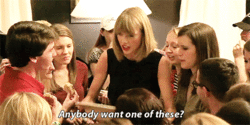
/giphy tasting a cookie
So supposing for a moment that GIFs don’t capture haecceities (or rather, that they capture no haecceity but their own), is there anything else that we can say about them? Well, if GIFs are mainly used for rhetorical effect, there should be endless possibilities for how they could be used. But in my experience, there’s only one way that they’re actually used, which is the one that’s implicit in the Terminator example I posted above: GIFs are a heightening move. We use them to pretend — without expecting to be believed — that our emotional lives are more histrionic than they actually are. It’s Friday, and I just clocked out for the day! Woo! Oh my tumblr brothers and sisters, I think my feelings can be best summed up by a GIF:

Except let’s be real: I’ve NEVER been as happy as that puppy. In fact (since dogs don’t actually smile like people do), even that puppy isn’t as happy as that puppy! Perfect eternal happiness is a paraeidolon. But online, we like to pretend that we live in ALL CAPS: that our particular personal griefs rise to the level of “GRIEF!” It strikes me that this is what GIFs are actually FOR.
This, at any rate, is the explanation of the GIF that makes most sense to me, and the one that informs my own GIFfing. (So if you ever see me posting that David Tennant clip, feel free to assume that I don’t really mean it. I’m probably bummed… but there’s no need to go calling social services.) I’d be remiss if I didn’t bring up a third possibility, however:
3) No GIF is perfect, all GIFs become perfect.
What if human emotions aren’t too specific for GIFs, but rather too general? And what’s more, too malleable? What if, when I’m clicking around looking for exactly the right GIF of a cat not giving a #$%^, I don’t even rightly know what it is that I feel? What if “The Perfect GIF” isn’t the one that captures what I already feel, but the one that condenses and concretizes my vague wash of sentiment into a feeling worthy of the name? What if, when I go browsing for GIFs (online or in my memories), I am also in essence browsing for emotions?
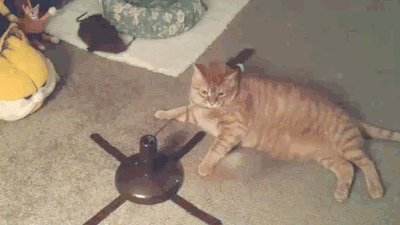
This one. This is the perfect one.
Let’s read this back into that David Tennant GIF. Something happens to make me upset (I drop my burrito), but right off the bat I don’t know how upset — in both quantity and quality — I should actually be. Then, when I pull up that GIF (either by searching for it, or again more plausibly by remembering it), I unconsciously decide to be exactly one David-Tennant-in-the-rain’s worth of upset. Now the GIF captures my experience perfectly, but not because it was a perfect fit. My feelings were a square peg, the GIF was a round hole… but the peg was made of playdough. The aspects of the experience that can’t be expressed are not expressed — and what’s more, they’re not really even experienced! (Note that on this account, GIFs turn out to be spooky witchcraft mind control.)

/giphy spooky witchcraft
Weird as the idea is, there’s some evidence from experimental psychology to suggest that our emotions are “squishy” in pretty much this way.
So which of these accounts seems most plausible to you? Or if that’s not a question that you’re interested in, we can just have a fight over how to pronounce it. I know you all have opinions on that, right? Come on, OTI commentariat, let’s settle this once and for all: is it “dgiff?” Or “ghiff?”

I think I am too illiterate for the internet. I have this friend who was always texting me gifs and I was always confused. Because most gifs are things that mean nothing to me. Most of them have layers of context and history that I am unfamiliar with because I don’t watch Adventure Time, or Rick and Morty, or Dr. Who. When I see a gif, all my thoughts go through a process like this (quoted from above) “How does Wrather feel about David Tennant — and how does he feel about Dr. Who? Which one of them are we supposed to be sympathizing with here? (Actually, are we supposed to be sympathizing at all? Or are we meant to be projecting ourselves into the character’s shoes, which is more of an empathetic kind of moment?) All of these questions are black-box aspects of Wrather’s own particular reaction to the GIF, knowable only to him.” And after I have spent sometime thinking on these questions I give up and delete the text because I have no idea the answers to any of them. So again I feel too dumb for the internet.
You know what you should do, is just write back a slightly excited literal description of what’s going on in the gif. So with the Dr. Who one, above, text “He’s getting rained on so hard!” Or with the Terminator 2 one, “That skeleton does NOT want to let go of the fence!” This will come across as super-cool ironic detachment.
(You know how you’re supposed to spend 10,000 hours at a skill to truly master it? Well consider me the Bill Gates of faking cultural competence.)
That bird magician makes fire in his hand! #slightlyexcitedliteraldescription
Allow me to definitely answer your final question with, appropriately, a .gif: http://i.imgur.com/0zp0Uin.gif
http://i.imgur.com/ByQzNv6.gif
Acronyms don’t work that way – JPEG, laser, Taser, IRA, etc.
And your offer of a gift is lovely! I’d like a gemstone, if you’d be so generous. I’m off to Geneva with my friend George tomorrow though – we’re riding giant giraffes around the lake, then partaking in some gin. He’s a geneticist and I’m an engineer, so we could both use a break from the drudgery of work.
(The real answer is I don’t care, but for the sake of internet fighting, soft “g” for life.)
I was gonna make the giraffe comment, but I can’t match this.
I will say though, that the “this is how you pronounce the letter g” argument is one of the weakest for the soft g partisans. After all, it’s pretty standard that a ‘g’ before any letter except ‘e’ or ‘i’ is pronounced like the ‘g’ in graphics and not the ‘j’ in jilt. So, really the case of it being a soft g is one of convention, not of pronunciation rules (especially because english pronunciation is actually seen as annoyingly arbitrary by speakers of many other languages).
dangit, I meant “definitively,” why can’t I ediiiiiiiiiiiiiiiiit….. man, it was supposed to be so cool and I RUINED IT. http://i.imgur.com/qXsm2cZ.gif
I wanted to use that table flip as the banner image for this post! (It truly is, The Perfect GIF.) Alas, the 1280 x 720 version of the file is 15 MB, which is too much awesomeness for our server to handle.
But as to the ‘jraphics’ argument: someone run this by the bigwigs at NATO and NASA.
(I pronounce GIF with a hard G all day long, though.)
Have you heard the one where it is not just a soft g a-la j, but also the i sound is not the eehh of a short i but an eye of long i, so gif is pronounced j-eye-f?
Yeah, whatever, you tumblr come latelies. Some of us were (correctly) pronouncing it with a soft “g” since Graphic Interchange Format v89a was specified in 1989. Yeah I was on the Internet then. Fight me.
GIFs may or may not be for expressing emotions or discourse, but they are most certainly not for spreading on toast nor for mixing with chocolate in fortuitous accidents.
I’m gonna do a little sidetrack here– please don’t kill me –because I feel like this is the only site in which it’ll be somewhat welcome.
Having trudged through nearly 2/3 of In Search of Lost Time ( AKA Remembrance of Things Past), before giving up, I want to inform you all that the damn cookie isn’t all that important. He talks about it for like maybe four pages in a book that uses that many pages to describe just the color of someone’s cheeks whose hair and eyes will need twice that many words to describe. And they probably won’t even be an important character, just some rando that the unnamed narrator is looking at at the moment. The cookie is actually a segue into a part of the book about his aunt and one of the many places he lived or stayed at for an extended period. It’s one of the better segues though. Sometimes he just launches semi-randomly into rhapsodies about flowers or descriptions and commentaries on the particulars of monocle fashion or the fuss that someone almost taking the wrong hat at a dinner party causes.
Again, this is a book where everything gets described at insane amounts of length. He describes in complete detail a fantasy future in which he gets married to a girl he sees from the train for like two minutes. And much of the books is taken up with the gossip, snubs, slights, comments, crushes and opinions of his particular social group full of semi-celebrities.
Ok. I don’t know how to bring that back to .gifs. I’ve just been wanting to say that for some time. Sorry. Thank you for listening.
Ah, wait. I have something: The cookie is for the 6 tome novel what .gif can be for a blog post. It’s a kind of exemplification and emotional abbreviation that simultaneously concentrates and heightens the feeling of a particular piece of writing.
One could theoretically just read the gifs of a tumblr post and mostly get the point. More importantly, he or she would probably get the feel and tone of the piece, even if they were missing the nuance. If all you’ve read or heard about Proust’s opus is the damn cookie, you actually have a not completely inaccurate, though somewhat heightened and reductive, feel for the book as a whole. There are spots in this book that are famous, and that stand out for their heights of emotion, imagery and virtuosic writing. But just like gifs are usually no the entirety of a piece of online writing, there is much more to the book. To stretch the analogy to a breaking-point, the rest of the book is more like trying to read about a man’s entire life by reading 50 years worth of his livejournal, facebook, twitter, and tumblr posts.
Ok. that’s all I got about Proust. Thanks for indulging me.
I wrote “read a .gif” without thinking about it, but does one ‘see’ a .gif? or ‘view’ it? what is the proper verb for engaging with a .gif?
In line with @DeanMoriarty – Please don’t kill me – but I want to connect this idea, the gif as an abreviation in feeling and tone for a online post, to the idea of Ben Adams most recent piece about the importance of quality in pop art (https://www.overthinkingit.com/2016/02/18/quality-matters/).
I think that the commercialization of pop art leads to investors (like studios) looking for the perfect gif of that art. If an executive cannot imagine the perfect gif of that pop art cultural artifact, then they will not green light the project. I read something interesting (http://www.cinemablend.com/new/How-Deadpool-Came-Up-With-Brilliant-Ferris-Bueller-Reference-112777.html) saying that Deadpool would not have been green lit without the post credits homage-a-Ferris-Bueller. The perfect gif of Deadpool, therefore is: Deadpool walking in down an oddly wallpapered hallway in full costume with a bathrobe saying, “You’re still here? Its over, go home! Go!”
I feel like your initial argument boils down to “all communication is inherently flawed” and “emotions are subjective” which I personally hold both to be true.
ust shy of four million, according to a recent Google Labs study
Really? Only 4 million? That sounds like an incredibly low number to me. I’d have thought it was orders of magnitude higher.
I thought of Gifs more like the internet’s crude form of showing accents through text. There’s been discussions since before I remember of the need to have a way to display sarcasm through the internet. As a perfect example, you just used capitals as emphasis for ‘smug asshole’ but then used it in the next sentence ‘so much better’ to denote sarcasm. Bold, italics, different fonts, leet, punctuation, smilies. Gifs are just another instance of this quest to perfect a ‘language of the internet’.